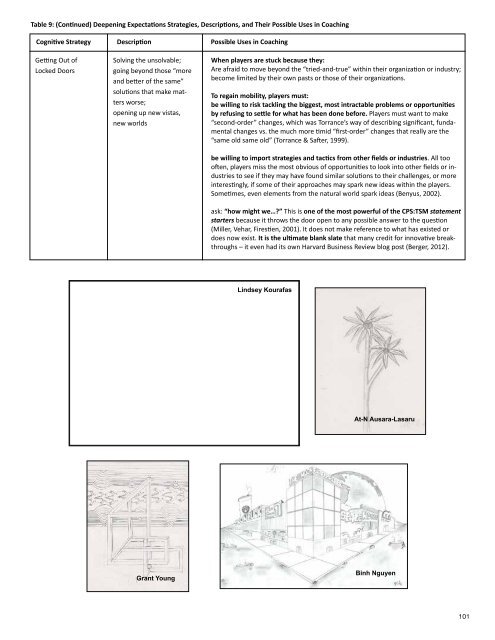Torrance Journal for Applied Creativity
TorranceJournal_V1
TorranceJournal_V1
Create successful ePaper yourself
Turn your PDF publications into a flip-book with our unique Google optimized e-Paper software.
Table 9: (Continued) Deepening Expectations Strategies, Descriptions, and Their Possible Uses in Coaching<br />
Cognitive Strategy Description Possible Uses in Coaching<br />
Getting Out of<br />
Locked Doors<br />
Solving the unsolvable;<br />
going beyond those “more<br />
and better of the same”<br />
solutions that make matters<br />
worse;<br />
opening up new vistas,<br />
new worlds<br />
When players are stuck because they:<br />
Are afraid to move beyond the “tried-and-true” within their organization or industry;<br />
become limited by their own pasts or those of their organizations.<br />
To regain mobility, players must:<br />
be willing to risk tackling the biggest, most intractable problems or opportunities<br />
by refusing to settle <strong>for</strong> what has been done be<strong>for</strong>e. Players must want to make<br />
“second-order” changes, which was <strong>Torrance</strong>’s way of describing significant, fundamental<br />
changes vs. the much more timid “first-order” changes that really are the<br />
“same old same old” (<strong>Torrance</strong> & Safter, 1999).<br />
be willing to import strategies and tactics from other fields or industries. All too<br />
often, players miss the most obvious of opportunities to look into other fields or industries<br />
to see if they may have found similar solutions to their challenges, or more<br />
interestingly, if some of their approaches may spark new ideas within the players.<br />
Sometimes, even elements from the natural world spark ideas (Benyus, 2002).<br />
ask: “how might we…?” This is one of the most powerful of the CPS:TSM statement<br />
starters because it throws the door open to any possible answer to the question<br />
(Miller, Vehar, Firestien, 2001). It does not make reference to what has existed or<br />
does now exist. It is the ultimate blank slate that many credit <strong>for</strong> innovative breakthroughs<br />
– it even had its own Harvard Business Review blog post (Berger, 2012).<br />
Lindsey Kourafas<br />
At-N Ausara-Lasaru<br />
Grant Young<br />
Binh Nguyen<br />
101


